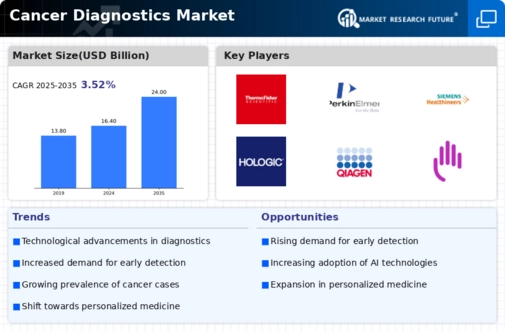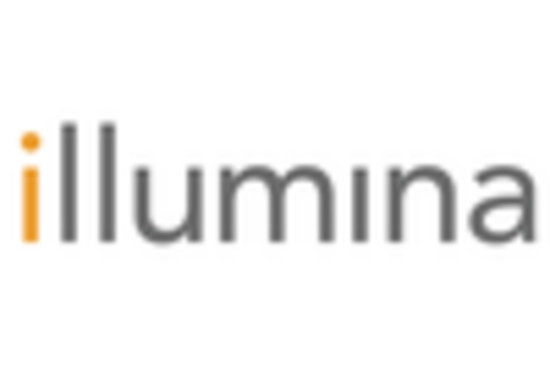Biopsy
Imaging
Blood Tests
Molecular Testing
Breast Cancer
Lung Cancer
Prostate Cancer
Colorectal Cancer
Hospitals
Diagnostic Laboratories
Research Institutes
Tissue Samples
Blood Samples
Urine Samples
North America
Europe
South America
Asia Pacific
Middle East and Africa
North America Outlook (USD Billion, 2019-2035)
North America Cancer Diagnostics Market by Test Type
Biopsy
Imaging
Blood Tests
Molecular Testing
North America Cancer Diagnostics Market by Cancer Type
Breast Cancer
Lung Cancer
Prostate Cancer
Colorectal Cancer
North America Cancer Diagnostics Market by End User Type
Hospitals
Diagnostic Laboratories
Research Institutes
North America Cancer Diagnostics Market by Sample Type
Tissue Samples
Blood Samples
Urine Samples
North America Cancer Diagnostics Market by Regional Type
US
Canada
US Outlook (USD Billion, 2019-2035)
US Cancer Diagnostics Market by Test Type
Biopsy
Imaging
Blood Tests
Molecular Testing
US Cancer Diagnostics Market by Cancer Type
Breast Cancer
Lung Cancer
Prostate Cancer
Colorectal Cancer
US Cancer Diagnostics Market by End User Type
Hospitals
Diagnostic Laboratories
Research Institutes
US Cancer Diagnostics Market by Sample Type
Tissue Samples
Blood Samples
Urine Samples
CANADA Outlook (USD Billion, 2019-2035)
CANADA Cancer Diagnostics Market by Test Type
Biopsy
Imaging
Blood Tests
Molecular Testing
CANADA Cancer Diagnostics Market by Cancer Type
Breast Cancer
Lung Cancer
Prostate Cancer
Colorectal Cancer
CANADA Cancer Diagnostics Market by End User Type
Hospitals
Diagnostic Laboratories
Research Institutes
CANADA Cancer Diagnostics Market by Sample Type
Tissue Samples
Blood Samples
Urine Samples
Europe Outlook (USD Billion, 2019-2035)
Europe Cancer Diagnostics Market by Test Type
Biopsy
Imaging
Blood Tests
Molecular Testing
Europe Cancer Diagnostics Market by Cancer Type
Breast Cancer
Lung Cancer
Prostate Cancer
Colorectal Cancer
Europe Cancer Diagnostics Market by End User Type
Hospitals
Diagnostic Laboratories
Research Institutes
Europe Cancer Diagnostics Market by Sample Type
Tissue Samples
Blood Samples
Urine Samples
Europe Cancer Diagnostics Market by Regional Type
Germany
UK
France
Russia
Italy
Spain
Rest of Europe
GERMANY Outlook (USD Billion, 2019-2035)
GERMANY Cancer Diagnostics Market by Test Type
Biopsy
Imaging
Blood Tests
Molecular Testing
GERMANY Cancer Diagnostics Market by Cancer Type
Breast Cancer
Lung Cancer
Prostate Cancer
Colorectal Cancer
GERMANY Cancer Diagnostics Market by End User Type
Hospitals
Diagnostic Laboratories
Research Institutes
GERMANY Cancer Diagnostics Market by Sample Type
Tissue Samples
Blood Samples
Urine Samples
UK Outlook (USD Billion, 2019-2035)
UK Cancer Diagnostics Market by Test Type
Biopsy
Imaging
Blood Tests
Molecular Testing
UK Cancer Diagnostics Market by Cancer Type
Breast Cancer
Lung Cancer
Prostate Cancer
Colorectal Cancer
UK Cancer Diagnostics Market by End User Type
Hospitals
Diagnostic Laboratories
Research Institutes
UK Cancer Diagnostics Market by Sample Type
Tissue Samples
Blood Samples
Urine Samples
FRANCE Outlook (USD Billion, 2019-2035)
FRANCE Cancer Diagnostics Market by Test Type
Biopsy
Imaging
Blood Tests
Molecular Testing
FRANCE Cancer Diagnostics Market by Cancer Type
Breast Cancer
Lung Cancer
Prostate Cancer
Colorectal Cancer
FRANCE Cancer Diagnostics Market by End User Type
Hospitals
Diagnostic Laboratories
Research Institutes
FRANCE Cancer Diagnostics Market by Sample Type
Tissue Samples
Blood Samples
Urine Samples
RUSSIA Outlook (USD Billion, 2019-2035)
RUSSIA Cancer Diagnostics Market by Test Type
Biopsy
Imaging
Blood Tests
Molecular Testing
RUSSIA Cancer Diagnostics Market by Cancer Type
Breast Cancer
Lung Cancer
Prostate Cancer
Colorectal Cancer
RUSSIA Cancer Diagnostics Market by End User Type
Hospitals
Diagnostic Laboratories
Research Institutes
RUSSIA Cancer Diagnostics Market by Sample Type
Tissue Samples
Blood Samples
Urine Samples
ITALY Outlook (USD Billion, 2019-2035)
ITALY Cancer Diagnostics Market by Test Type
Biopsy
Imaging
Blood Tests
Molecular Testing
ITALY Cancer Diagnostics Market by Cancer Type
Breast Cancer
Lung Cancer
Prostate Cancer
Colorectal Cancer
ITALY Cancer Diagnostics Market by End User Type
Hospitals
Diagnostic Laboratories
Research Institutes
ITALY Cancer Diagnostics Market by Sample Type
Tissue Samples
Blood Samples
Urine Samples
SPAIN Outlook (USD Billion, 2019-2035)
SPAIN Cancer Diagnostics Market by Test Type
Biopsy
Imaging
Blood Tests
Molecular Testing
SPAIN Cancer Diagnostics Market by Cancer Type
Breast Cancer
Lung Cancer
Prostate Cancer
Colorectal Cancer
SPAIN Cancer Diagnostics Market by End User Type
Hospitals
Diagnostic Laboratories
Research Institutes
SPAIN Cancer Diagnostics Market by Sample Type
Tissue Samples
Blood Samples
Urine Samples
REST OF EUROPE Outlook (USD Billion, 2019-2035)
REST OF EUROPE Cancer Diagnostics Market by Test Type
Biopsy
Imaging
Blood Tests
Molecular Testing
REST OF EUROPE Cancer Diagnostics Market by Cancer Type
Breast Cancer
Lung Cancer
Prostate Cancer
Colorectal Cancer
REST OF EUROPE Cancer Diagnostics Market by End User Type
Hospitals
Diagnostic Laboratories
Research Institutes
REST OF EUROPE Cancer Diagnostics Market by Sample Type
Tissue Samples
Blood Samples
Urine Samples
APAC Outlook (USD Billion, 2019-2035)
APAC Cancer Diagnostics Market by Test Type
Biopsy
Imaging
Blood Tests
Molecular Testing
APAC Cancer Diagnostics Market by Cancer Type
Breast Cancer
Lung Cancer
Prostate Cancer
Colorectal Cancer
APAC Cancer Diagnostics Market by End User Type
Hospitals
Diagnostic Laboratories
Research Institutes
APAC Cancer Diagnostics Market by Sample Type
Tissue Samples
Blood Samples
Urine Samples
APAC Cancer Diagnostics Market by Regional Type
China
India
Japan
South Korea
Malaysia
Thailand
Indonesia
Rest of APAC
CHINA Outlook (USD Billion, 2019-2035)
CHINA Cancer Diagnostics Market by Test Type
Biopsy
Imaging
Blood Tests
Molecular Testing
CHINA Cancer Diagnostics Market by Cancer Type
Breast Cancer
Lung Cancer
Prostate Cancer
Colorectal Cancer
CHINA Cancer Diagnostics Market by End User Type
Hospitals
Diagnostic Laboratories
Research Institutes
CHINA Cancer Diagnostics Market by Sample Type
Tissue Samples
Blood Samples
Urine Samples
INDIA Outlook (USD Billion, 2019-2035)
INDIA Cancer Diagnostics Market by Test Type
Biopsy
Imaging
Blood Tests
Molecular Testing
INDIA Cancer Diagnostics Market by Cancer Type
Breast Cancer
Lung Cancer
Prostate Cancer
Colorectal Cancer
INDIA Cancer Diagnostics Market by End User Type
Hospitals
Diagnostic Laboratories
Research Institutes
INDIA Cancer Diagnostics Market by Sample Type
Tissue Samples
Blood Samples
Urine Samples
JAPAN Outlook (USD Billion, 2019-2035)
JAPAN Cancer Diagnostics Market by Test Type
Biopsy
Imaging
Blood Tests
Molecular Testing
JAPAN Cancer Diagnostics Market by Cancer Type
Breast Cancer
Lung Cancer
Prostate Cancer
Colorectal Cancer
JAPAN Cancer Diagnostics Market by End User Type
Hospitals
Diagnostic Laboratories
Research Institutes
JAPAN Cancer Diagnostics Market by Sample Type
Tissue Samples
Blood Samples
Urine Samples
SOUTH KOREA Outlook (USD Billion, 2019-2035)
SOUTH KOREA Cancer Diagnostics Market by Test Type
Biopsy
Imaging
Blood Tests
Molecular Testing
SOUTH KOREA Cancer Diagnostics Market by Cancer Type
Breast Cancer
Lung Cancer
Prostate Cancer
Colorectal Cancer
SOUTH KOREA Cancer Diagnostics Market by End User Type
Hospitals
Diagnostic Laboratories
Research Institutes
SOUTH KOREA Cancer Diagnostics Market by Sample Type
Tissue Samples
Blood Samples
Urine Samples
MALAYSIA Outlook (USD Billion, 2019-2035)
MALAYSIA Cancer Diagnostics Market by Test Type
Biopsy
Imaging
Blood Tests
Molecular Testing
MALAYSIA Cancer Diagnostics Market by Cancer Type
Breast Cancer
Lung Cancer
Prostate Cancer
Colorectal Cancer
MALAYSIA Cancer Diagnostics Market by End User Type
Hospitals
Diagnostic Laboratories
Research Institutes
MALAYSIA Cancer Diagnostics Market by Sample Type
Tissue Samples
Blood Samples
Urine Samples
THAILAND Outlook (USD Billion, 2019-2035)
THAILAND Cancer Diagnostics Market by Test Type
Biopsy
Imaging
Blood Tests
Molecular Testing
THAILAND Cancer Diagnostics Market by Cancer Type
Breast Cancer
Lung Cancer
Prostate Cancer
Colorectal Cancer
THAILAND Cancer Diagnostics Market by End User Type
Hospitals
Diagnostic Laboratories
Research Institutes
THAILAND Cancer Diagnostics Market by Sample Type
Tissue Samples
Blood Samples
Urine Samples
INDONESIA Outlook (USD Billion, 2019-2035)
INDONESIA Cancer Diagnostics Market by Test Type
Biopsy
Imaging
Blood Tests
Molecular Testing
INDONESIA Cancer Diagnostics Market by Cancer Type
Breast Cancer
Lung Cancer
Prostate Cancer
Colorectal Cancer
INDONESIA Cancer Diagnostics Market by End User Type
Hospitals
Diagnostic Laboratories
Research Institutes
INDONESIA Cancer Diagnostics Market by Sample Type
Tissue Samples
Blood Samples
Urine Samples
REST OF APAC Outlook (USD Billion, 2019-2035)
REST OF APAC Cancer Diagnostics Market by Test Type
Biopsy
Imaging
Blood Tests
Molecular Testing
REST OF APAC Cancer Diagnostics Market by Cancer Type
Breast Cancer
Lung Cancer
Prostate Cancer
Colorectal Cancer
REST OF APAC Cancer Diagnostics Market by End User Type
Hospitals
Diagnostic Laboratories
Research Institutes
REST OF APAC Cancer Diagnostics Market by Sample Type
Tissue Samples
Blood Samples
Urine Samples
South America Outlook (USD Billion, 2019-2035)
South America Cancer Diagnostics Market by Test Type
Biopsy
Imaging
Blood Tests
Molecular Testing
South America Cancer Diagnostics Market by Cancer Type
Breast Cancer
Lung Cancer
Prostate Cancer
Colorectal Cancer
South America Cancer Diagnostics Market by End User Type
Hospitals
Diagnostic Laboratories
Research Institutes
South America Cancer Diagnostics Market by Sample Type
Tissue Samples
Blood Samples
Urine Samples
South America Cancer Diagnostics Market by Regional Type
Brazil
Mexico
Argentina
Rest of South America
BRAZIL Outlook (USD Billion, 2019-2035)
BRAZIL Cancer Diagnostics Market by Test Type
Biopsy
Imaging
Blood Tests
Molecular Testing
BRAZIL Cancer Diagnostics Market by Cancer Type
Breast Cancer
Lung Cancer
Prostate Cancer
Colorectal Cancer
BRAZIL Cancer Diagnostics Market by End User Type
Hospitals
Diagnostic Laboratories
Research Institutes
BRAZIL Cancer Diagnostics Market by Sample Type
Tissue Samples
Blood Samples
Urine Samples
MEXICO Outlook (USD Billion, 2019-2035)
MEXICO Cancer Diagnostics Market by Test Type
Biopsy
Imaging
Blood Tests
Molecular Testing
MEXICO Cancer Diagnostics Market by Cancer Type
Breast Cancer
Lung Cancer
Prostate Cancer
Colorectal Cancer
MEXICO Cancer Diagnostics Market by End User Type
Hospitals
Diagnostic Laboratories
Research Institutes
MEXICO Cancer Diagnostics Market by Sample Type
Tissue Samples
Blood Samples
Urine Samples
ARGENTINA Outlook (USD Billion, 2019-2035)
ARGENTINA Cancer Diagnostics Market by Test Type
Biopsy
Imaging
Blood Tests
Molecular Testing
ARGENTINA Cancer Diagnostics Market by Cancer Type
Breast Cancer
Lung Cancer
Prostate Cancer
Colorectal Cancer
ARGENTINA Cancer Diagnostics Market by End User Type
Hospitals
Diagnostic Laboratories
Research Institutes
ARGENTINA Cancer Diagnostics Market by Sample Type
Tissue Samples
Blood Samples
Urine Samples
REST OF SOUTH AMERICA Outlook (USD Billion, 2019-2035)
REST OF SOUTH AMERICA Cancer Diagnostics Market by Test Type
Biopsy
Imaging
Blood Tests
Molecular Testing
REST OF SOUTH AMERICA Cancer Diagnostics Market by Cancer Type
Breast Cancer
Lung Cancer
Prostate Cancer
Colorectal Cancer
REST OF SOUTH AMERICA Cancer Diagnostics Market by End User Type
Hospitals
Diagnostic Laboratories
Research Institutes
REST OF SOUTH AMERICA Cancer Diagnostics Market by Sample Type
Tissue Samples
Blood Samples
Urine Samples
MEA Outlook (USD Billion, 2019-2035)
MEA Cancer Diagnostics Market by Test Type
Biopsy
Imaging
Blood Tests
Molecular Testing
MEA Cancer Diagnostics Market by Cancer Type
Breast Cancer
Lung Cancer
Prostate Cancer
Colorectal Cancer
MEA Cancer Diagnostics Market by End User Type
Hospitals
Diagnostic Laboratories
Research Institutes
MEA Cancer Diagnostics Market by Sample Type
Tissue Samples
Blood Samples
Urine Samples
MEA Cancer Diagnostics Market by Regional Type
GCC Countries
South Africa
Rest of MEA
GCC COUNTRIES Outlook (USD Billion, 2019-2035)
GCC COUNTRIES Cancer Diagnostics Market by Test Type
Biopsy
Imaging
Blood Tests
Molecular Testing
GCC COUNTRIES Cancer Diagnostics Market by Cancer Type
Breast Cancer
Lung Cancer
Prostate Cancer
Colorectal Cancer
GCC COUNTRIES Cancer Diagnostics Market by End User Type
Hospitals
Diagnostic Laboratories
Research Institutes
GCC COUNTRIES Cancer Diagnostics Market by Sample Type
Tissue Samples
Blood Samples
Urine Samples
SOUTH AFRICA Outlook (USD Billion, 2019-2035)
SOUTH AFRICA Cancer Diagnostics Market by Test Type
Biopsy
Imaging
Blood Tests
Molecular Testing
SOUTH AFRICA Cancer Diagnostics Market by Cancer Type
Breast Cancer
Lung Cancer
Prostate Cancer
Colorectal Cancer
SOUTH AFRICA Cancer Diagnostics Market by End User Type
Hospitals
Diagnostic Laboratories
Research Institutes
SOUTH AFRICA Cancer Diagnostics Market by Sample Type
Tissue Samples
Blood Samples
Urine Samples
REST OF MEA Outlook (USD Billion, 2019-2035)
REST OF MEA Cancer Diagnostics Market by Test Type
Biopsy
Imaging
Blood Tests
Molecular Testing
REST OF MEA Cancer Diagnostics Market by Cancer Type
Breast Cancer
Lung Cancer
Prostate Cancer
Colorectal Cancer
REST OF MEA Cancer Diagnostics Market by End User Type
Hospitals
Diagnostic Laboratories
Research Institutes
REST OF MEA Cancer Diagnostics Market by Sample Type
Tissue Samples
Blood Samples
Urine Samples

















Leave a Comment